





Understanding Swear Words – Social Story for Respectful Communication
₹80
₹160
50% off
0 (0 ratings)
Grade Levels
Pre-K - Grade 3 (Ages 4-9)
Content Overview
Format: Printable PDF, Total Pages: 11, Features: 16 real-life scenarios, engaging illustrations, 6 interactive activities
Categories
Pages from the Resource
This social story helps children understand why swear words can be inappropriate and teaches them better ways to express their feelings. With real-life examples and interactive activities, kids learn respectful language and communication skills in a fun and structured way. Ideal for kids with autism, ADHD, and social-emotional learning needs.

Page 1

Page 2
What Users Say
0
0 ratings
5
0+
4
0+
3
0+
2
0+
1
0+
5 Stars
Product is Good to use.
9 months ago
Varsha Parent
Similar Products
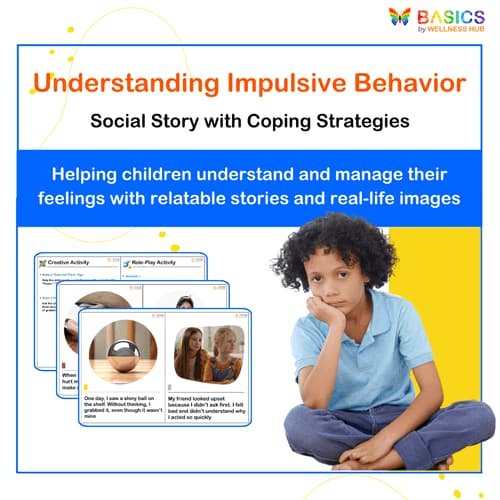
Understanding Impulsive Behavior: Social Story with Coping Strategies
₹ 80.00
₹ 160.00
50% off
4.9 (42 ratings)
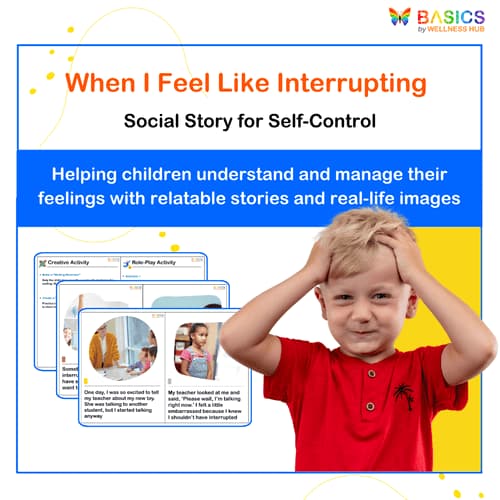
When I Feel Like Interrupting – Social Story for Self-Control
₹ 80.00
₹ 160.00
50% off
4.8 (60 ratings)
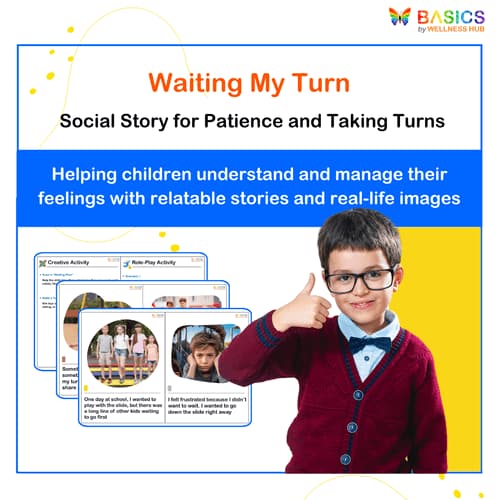
Waiting My Turn – Social Story for Patience and Taking Turns
₹ 80.00
₹ 160.00
50% off
4.7 (56 ratings)
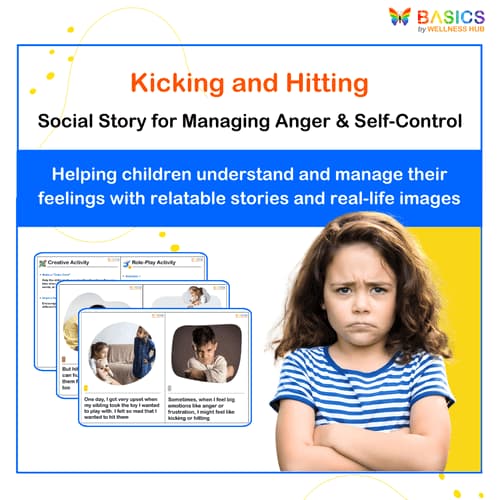
Kicking and Hitting – Social Story for Managing Anger & Self-Control
₹ 80.00
₹ 160.00
50% off
4.6 (52 ratings)
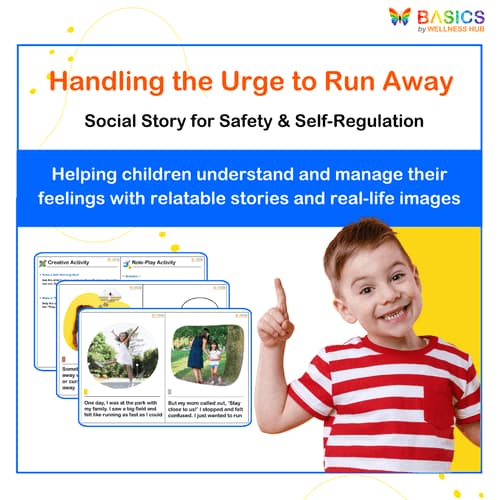
Handling the Urge to Run Away – Social Story for Safety & Self-Regulation
₹ 80.00
₹ 160.00
50% off
4.8 (44 ratings)
About the Product
Young children are naturally curious about language, and at some point, they may hear or use swear words or inappropriate language without fully understanding their impact. Many children, especially those with autism, ADHD, or speech and language delays, may not recognize why certain words are offensive or inappropriate in social settings.
This printable social story is designed to:
✔ Help children understand what swear words are and why some words are considered inappropriate.
✔ Teach alternative ways to express frustration, excitement, or strong emotions without using offensive language.
✔ Encourage respectful communication in different social situations, such as at home, school, and in public places.
Through first-person storytelling, engaging illustrations, and interactive activities, this social story guides children in making better word choices, improving self-regulation, and learning how to communicate in a respectful way.
This resource is ideal for:
✔ Preschoolers and early learners who are beginning to develop social and language skills.
✔ Children with autism, ADHD, or sensory processing challenges who need clear, structured guidance on appropriate language use.
✔ Parents, teachers, and therapists looking for a gentle and structured way to teach kids about language boundaries.
By reinforcing positive behavior, emotional awareness, and appropriate word choices, this social story empowers children to use respectful communication in all settings.
Product Details
- Format: Printable PDF
- Total Pages: 11
- Segments: 16 real-life scenarios teaching appropriate language and self-regulation.
- Features:
✔ Engaging illustrations to support understanding.
✔ First-person storytelling to help children relate to the lesson.
✔ 6 interactive activities that reinforce positive communication strategies.
✔ Simple, child-friendly language for easy comprehension.
✔ Scenarios include: Understanding swear words, learning alternative phrases, expressing emotions without inappropriate words, and making respectful word choices.
This structured social story is a valuable tool for teaching respectful communication, self-awareness, and social-emotional skills to young children.
Educational Benefits
This social story provides a structured and engaging way to teach children how to use appropriate language and understand social boundaries around words.
1. Teaches Language Awareness & Social Appropriateness
✔ Helps children recognize what swear words are and why they may be offensive.
✔ Provides clear explanations of when certain words are inappropriate and how they affect others.
✔ Encourages children to think before speaking and consider their word choices.
2. Encourages Alternative Ways to Express Emotions
Instead of using inappropriate words, children are encouraged to:
✔ Use emotion words like "I’m frustrated" instead of swearing.
✔ Take deep breaths or count to five before reacting.
✔ Use funny or silly alternative words instead of bad words.
✔ Talk to a trusted adult when they hear a new word they don’t understand.
3. Supports Social-Emotional Learning (SEL) & Special Needs
✔ Designed for children with autism, ADHD, and speech/language delays.
✔ Uses clear, structured lessons to make concepts easy to understand.
4. Reinforces Learning with Interactive Activities
✔ Helps children practice and apply respectful communication strategies.
✔ Includes hands-on learning opportunities through discussions, role-playing, and drawing activities.
This step-by-step approach ensures that children internalize and apply these respectful communication strategies, leading to better social interactions and self-expression.
Instructions for Use
This social story should be used consistently to help children develop language awareness and self-regulation skills.
1. Read & Discuss the Story
- Read the story aloud with your child or student.
- Pause at key moments to ask reflection questions:
"What should we do when we hear a word we don’t understand?"
"How do we know if a word is hurtful?"
"What can we say instead of a bad word?"
2. Use Real-Life Examples & Visual Cues
- Identify real-life moments when a child hears or wants to use a swear word and gently remind them of the social story.
- Use visual reminders like an "Alternative Words" chart in classrooms, homes, and therapy rooms.
- Model respectful communication by using polite and positive language.
3. Engage in Interactive Activities
- Use the six included activities to reinforce key strategies:
✔ Role-Playing Conversations – Practicing how to express feelings without bad words.
✔ "Good Words vs. Not-So-Good Words" Sorting Activity – Identifying appropriate word choices.
✔ Social Scenario Matching – Recognizing situations where words can impact others.
✔ Emotion Expression Chart – Teaching different ways to express strong feelings.
✔ Comprehension Questions – Checking understanding of the story.
✔ Creative Activity – Drawing or role-playing positive word choices.
4. Reinforce Positive Behavior Daily
- Model respectful language in different situations.
- Praise positive word choices when a child chooses to use kind and respectful language instead of swearing:
"Great job saying ‘I’m upset’ instead of using a bad word!"
"I love how you used a funny word instead of swearing!"
Activities Using the Resource
This printable social story includes engaging, hands-on activities that help children understand the impact of words, learn alternatives to swearing, and practice self-regulation in different social settings.
1. "Good Words vs. Not-So-Good Words" Sorting Activity
Objective: Help children differentiate between respectful and inappropriate words.
✔ Materials: Printable sorting cards with different words and phrases.
✔ How to Play:
- Show different words and phrases, including both respectful alternatives and commonly used inappropriate words (e.g., “Oh no!” vs. swear words).
- Have the child sort them into two categories:
✔ Good Words (respectful, kind, and acceptable).
✔ Not-So-Good Words (words that can hurt or offend others). - Discuss why some words belong in each category and how words affect others.
2. "What Should I Say Instead?" Discussion Cards
Objective: Teach children how to replace swear words with appropriate alternatives.
✔ Materials: Printable discussion prompt cards.
✔ How to Play:
- Read a scenario aloud (e.g., "You stub your toe and feel like shouting a bad word. What can you say instead?").
- Encourage the child to think and respond with a respectful alternative.
- Reinforce positive thinking and self-awareness through discussion.
3. "Role-Playing Conversations" Exercise
Objective: Teach children how to express frustration, excitement, or surprise without using inappropriate language.
✔ Materials: No materials needed, just role-playing.
✔ How to Play:
- Call out different scenarios where children might hear or want to use a bad word (e.g., “Someone cut in line,” “You dropped your toy,” “You lost a game”).
- Have the child practice responding in a respectful way by:
✔ Using an alternative word or phrase.
✔ Explaining how they feel without swearing.
✔ Taking a deep breath before speaking. - Reinforce positive choices with praise and encouragement.
4. "Express Your Emotions" Chart
Objective: Help children identify their emotions and choose respectful words.
✔ Materials: Printable "Emotion Expression" chart.
✔ How to Play:
- Show different emotion faces (angry, frustrated, excited, surprised).
- Ask the child, “How do you feel when you want to say a bad word?”
- Have them choose a better way to express that emotion using the chart:
Instead of: “This is so stupid!” → Say: “This is really frustrating!”
Instead of: “What the heck?” → Say: “That surprised me!”
5. "Draw & Describe" Creative Activity
Objective: Help children visualize and describe situations where they can use appropriate language.
✔ Materials: Paper and crayons.
✔ How to Play:
- Have the child draw a picture of a time they felt frustrated, surprised, or excited.
- Ask them to describe what they could say instead of a bad word.
- Reinforce positive word choices and respectful communication.
FAQs
Q1. Who is this social story designed for?
This resource is designed for children ages 4-9 who need help understanding why some words are inappropriate and how to use respectful alternatives. It is especially helpful for:
✔ Kids who are learning about language boundaries.
✔ Children with autism, ADHD, and speech or language delays.
✔ Parents, teachers, and therapists looking for structured tools to teach respectful communication skills.
Q2. How do I use this social story effectively?
✔ Read the story regularly – Repetition helps children internalize the lesson.
✔ Ask open-ended questions – "What should you do when you hear a word you don’t know?"
✔ Use the interactive activities – Reinforce learning through role-playing and sorting games.
✔ Praise good behavior – Reinforce self-regulation with positive reinforcement.
Q3. Can this be used in therapy sessions?
Yes! This printable social story is an excellent tool for:
✔ Speech therapists, occupational therapists, behavioral therapists, and special educators.
✔ Social-emotional learning (SEL) lessons in therapy and classroom settings.
Q4. Does this resource include interactive activities?
Yes! Along with the 16 real-life segments, this story includes 6 structured activities that help children practice and reinforce positive communication strategies.
Q5. Is this a printable or a physical book?
This is a printable PDF that you can download instantly. It is not a physical book, but you can print it or use it digitally on a tablet.
Q6. Can this be used in a classroom setting?
Absolutely! Teachers can:
✔ Use it during social-emotional learning (SEL) lessons.
✔ Read it aloud to small groups to discuss appropriate and respectful language.
✔ Use role-play activities to help students practice better word choices.
Q7. How can I reinforce these lessons at home?
✔ Model respectful language – Show your child how to replace swear words with better alternatives.
✔ Praise positive choices – Reinforce when they choose an appropriate word instead of a bad one.
✔ Use reminders – Visual cue cards, posters, and charts can help reinforce better word choices.
Usage Rights and Restrictions
To ensure ethical use of this resource, please follow these guidelines:
Allowed:
✅ Personal use by parents, educators, and therapists.
✅ Printing multiple copies for your classroom or therapy sessions.
✅ Using digitally on a tablet or computer.
Not Allowed:
❌ Sharing, distributing, or reselling this resource in any format.
❌ Uploading the PDF to online platforms or third-party websites.
❌ Modifying the content for commercial purposes.
For bulk licensing or school-wide access, please contact us for special permissions.
Conclusion
"Understanding Swear Words – Social Story for Respectful Communication" is an engaging and structured way to help children:
✔ Recognize inappropriate words and their impact.
✔ Learn alternative ways to express their emotions.
✔ Develop impulse control, self-awareness, and respectful communication skills.
By using real-life scenarios, engaging illustrations, and structured activities, this printable social story helps children transition from using inappropriate words to respectful communication.
Instant download – Start using it today!
Perfect for home, school, and therapy sessions.



